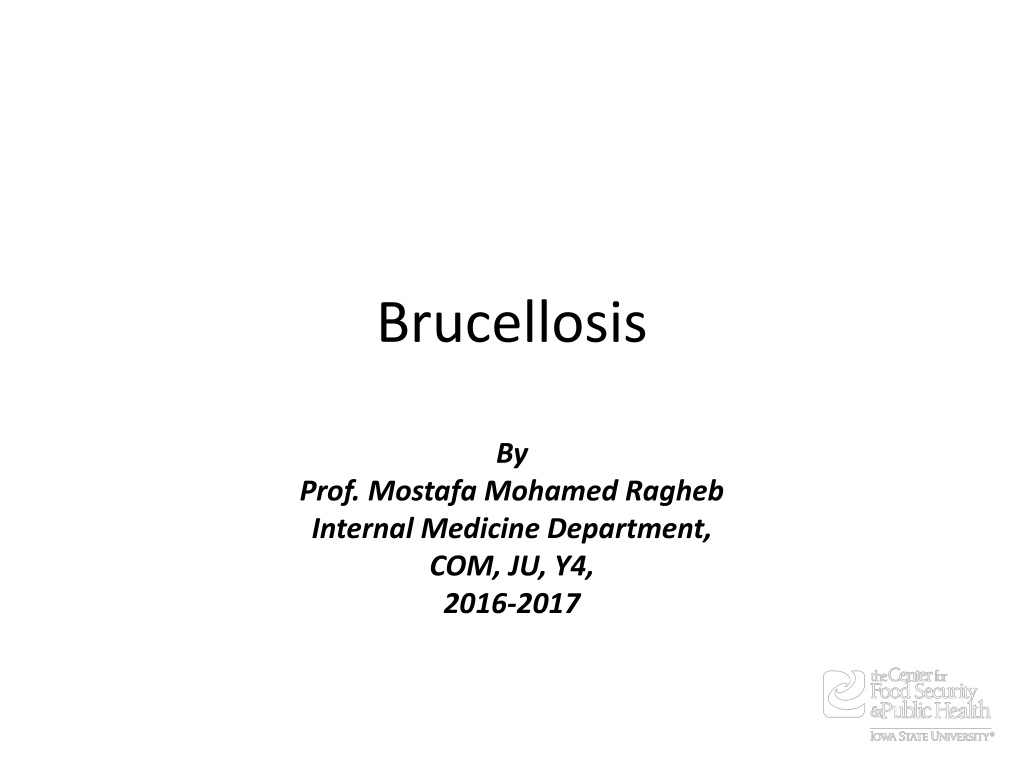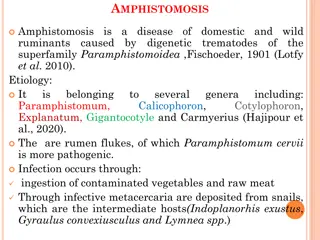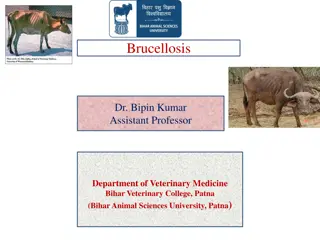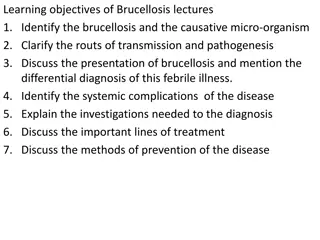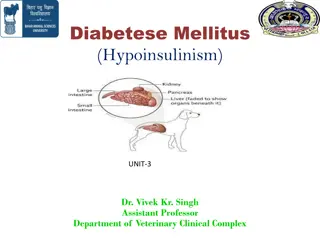Understanding Brucellosis: Causes, Symptoms, Diagnosis, and Treatment
Brucellosis, also known as Undulant Fever or Malta Fever, is a zoonotic disease caused by Brucella spp. Learn about its etiology, transmission, manifestations, diagnosis, treatment, and preventive aspects. Discover the history of Brucellosis and populations at risk. Explore the epidemiology, including high-risk groups, and the impact of Brucella melitensis on sheep and goats in specific regions. Gain insights into the distribution, incidence rates, and preventive measures against this infectious disease.
Download Presentation

Please find below an Image/Link to download the presentation.
The content on the website is provided AS IS for your information and personal use only. It may not be sold, licensed, or shared on other websites without obtaining consent from the author. Download presentation by click this link. If you encounter any issues during the download, it is possible that the publisher has removed the file from their server.
E N D
Presentation Transcript
Brucellosis By Prof. Mostafa Mohamed Ragheb Internal Medicine Department, COM, JU, Y4, 2016-2017
Brucellosis or called Undulant Fever, Malta Fever, Mediterranean Fever Intended learning objectives: Etiology Transmission Manifestations Diagnosis Treatment Duration of therapy and follow up Preventive aspect
Brucella spp. Brucellosis is a zoonotic disease caused by various species of the genus Brucella, Gram negative, facultative anerobe intracellular bacteria (coccobacillus or short rods). Each Brucella species is associated most often with certain mammalian hosts. The organism is able to withstand drying, particularly when organic material is present and can survive in dust and soil. Center for Food Security and Public Health, Iowa State University, 2012
Brucella spp. In conditions of high humidity, low temperatures, and no sunlight, these organisms can remain viable for several months in water, aborted fetuses, manure, wool, hay, equipment and clothing. Brucella spp. can survive even longer at lower temperatures, particularly when it is below freezing. Center for Food Security and Public Health, Iowa State University, 2012
Center for Food Security and Public Health, Iowa State University, 2012
History of Brucellosis 450 BC: Described by Hippocrates 1905: Introduced to the U.S. 1914: B. suis Indiana, United States 1953: B. ovis New Zealand, Australia 1966: B. canis Dogs, caribou, and reindeer Center for Food Security and Public Health, Iowa State University, 2012
Epidemiology: Populations at Risk Occupational disease Cattle ranchers/dairy farmers Veterinarians Abattoir workers Meat inspectors Lab workers Hunters Travelers Consumers of unpasteurized dairy products Center for Food Security and Public Health, Iowa State University, 2012
Brucella melitensis: in Sheep and goats Distribution Mediterranean, Middle East, Central Asia, parts of Central America Incidence Mediterranean, Middle East 78 cases/100,000 people/yr Arabic Peninsula 20% seroprevalence; 2% active cases 100 to 200 U.S. cases annually Unpasteurized cheeses Center for Food Security and Public Health, Iowa State University, 2012
Brucella abortus: in cows Distribution Worldwide Eradicated in some countries Notifiable disease in many countries World Organization for Animal Health (OIE) Poor surveillance and reporting due to lack of recognition Fever of unknown origin (FUO) Center for Food Security and Public Health, Iowa State University, 2012
Brucella suis: in pigs Five biovars 1 and 3: Worldwide in swine 1: Cattle in Brazil and Columbia 2: Wild hares, boars in Europe 4: Arctic region (N. America, Russia) 5: Former USSR Eradicated from domestic pigs U.S., Canada, much of Europe Persistent problem in feral swine U.S., Europe, parts of Australia Center for Food Security and Public Health, Iowa State University, 2012
Brucella ovis Distribution: most sheep-raising regions of the world Australia New Zealand North America South America South Africa Many European countries Center for Food Security and Public Health, Iowa State University, 2012
Brucella canis Distribution Probably worldwide Prevalence unknown United States: 1 to 19% Mexico: up to 28% Central and South America: 30% Human infections Possible but uncommon Center for Food Security and Public Health, Iowa State University, 2012
Remember The majority of human infections result from B. melitensis, the most pathogenic species in man Center for Food Security and Public Health, Iowa State University, 2012
Camels, infection and Brucellosis Camels are highly susceptible to certain bacterial pathogens such as Bacillus anthracis, Mycobacterium spp, Clostridium spp, Pasteurella spp, Salmonella spp, Brucella spp and MERS- COV Camels are infected by B. abortus and B. melitensis. Brucellosis in camels is an insidious disease, since it hardly provokes any clinical signs, and may furthermore cause problems in the laboratory due to the lack of sufficiently validated tests. Center for Food Security and Public Health, Iowa State University, 2012
Brucellosis: U.S. Incidence Most associated with consumption of unpasteurized foreign cheeses Center for Food Security and Public Health, Iowa State University, 2012
Transmission in Humans (Occupational disease) Ingestion Raw milk, unpasteurized dairy products Rarely through undercooked meat Contact of mucous membrane or abraded skin with infected tissues as animal abortion products (Vaginal discharge, aborted fetuses, placentas), or tissue samples in pathology labs Center for Food Security and Public Health, Iowa State University, 2012
Transmission in Humans Aerosol Laboratory, abattoirs Animal houses, stables, slaughter houses Bioterorrism Self inoculation by a needle stick during animal immunization by a live vaccine Conjunctival splashes, injection Are modes of transmission: assexual, breast feeding, blood transfusion or BM transplantation Center for Food Security and Public Health, Iowa State University, 2012
Bioterrorism Other bioterrorism agents Bioterrorism: brucellosis Disease Agent Agent Type causes prolonged Bacillus anthracis Anthrax Bacteria morbidity and low Clostridium botulinum toxin fatality. It is likely to be Botulism Bacterial toxin distributed by aerosol or Plague, Pneumonic Yersinia pestis Bacteria contamination of food. Smallpox Variola major Virus Center for Food Security and Public Health, Iowa State University, 2012
Pathophysiology After inoculation, Brucella invade the mucosa, where PMN leukocytes and activated macrophages mediate immune responses to eradicate the bacteria. However, brucellae can multiply and survive intracellularly by inhibiting and counteracting bactericidal effects within the phagosome [ Brucella have lipopolysaccharide coat]. They are then transported intracellularly via the lymphatics to organs rich in reticuloendothelial cells, and from there travel to other organs and tissues, where they can cause inflammation, granuloma formation, necrosis, and abscess formation.
Pathophysiology In animals, the infection localizes in the erythritol-rich placenta; this effect is less marked in humans but can still result in abortion or miscarriage. Immunity following exposure is not solid, and people may experience reinfection as well as relapse.
Pathophysiology Brucella species have relatively low virulence, toxicity, and pyrogenicity, making them poor inducers of some inflammatory cytokines, such as tumor necrosis factor (TNF) and interferons. Development of cell-mediated immunity is the principal mechanism of development of tissue granulomas. recovery leading to Center for Food Security and Public Health, Iowa State University, 2012
Disease in Humans Incubation period Variable; 5-21 days (up to 3 months) Multisystemic Any organ or organ system Cyclical fever Flu-like illness May wax and wane Chronic illness possible Center for Food Security and Public Health, Iowa State University, 2012
Clinical picture 1) Subclinical disease: is the commonest and commonly met with in endemic areas. 2) Chronic brucellosis: malaise, weakness, prostration, profound sweating, generalized aches, arthralgia, joint swelling, prolonged mental depression without fever.
Clinical picture 3-Acute or subacute brucellosis: (a)Non-specific early symptoms:fever, chills, sweat, generalized aches and pain. Fever is after-noon fever in acute, and undulant in subacute (episodic fever with afebrile periods lasting for few days, followed by fever for 1-3 weeks). Splenomegaly (20%), lymphadenopathy (10%). Pregnant women abort spontaneously . (b)Relapsing disease: without treatment infection resolve spontaneously after several months, symptomatic relapse may occur at intervals over several years.
Undulant fever: febrile days alternating with fever-free days is characteristics of subacute brucellosis
Complications of Brucellosis Complications are seen occasionally, particularly in the undulant and chronic forms. Most common: Arthritis, spondylitis, epididymo-orchitis, chronic fatigue Neurological deficits in 5% of cases, depression. Meningitis, encephalitis, peipheral neuropathy Other complications : Ocular (Uveitis, optic neuritis and papilledema ), cardiovascular, (fatal endocarditis) additional organs and tissues (nephritis, dermatitis, vasculitis, lymphadenopathy, deep vein thrombosis, granulomatous hepatitis, cholecystitis, osteomyelitis, anemia, leukopenia and thrombocytopenia. Abscesses can occur in internal organs.) Center for Food Security and Public Health, Iowa State University, 2012
Center for Food Security and Public Health, Iowa State University, 2012
Signs In 50% of patients: arthritis, spinal tenderness. In 25% of patients: looks ill, pallor, lymphadenopathy, splenomegaly, hepatomegaly, epididymo-orchitis, skin rash. Less than 5%: jaundice, central nervous system (CNS) abnormalities, cardiac murmur, pneumonia. Center for Food Security and Public Health, Iowa State University, 2012
Diagnosis in Humans In humans, the definitive diagnosis is by culture or serology. Isolation of organism: Early in infection the organism can be isolated from culture of blood, bone marrow, other tissues: The physician should tell the lab about the possibility of brucellosis, for infection control measures. Air in culture bottles are replaced with air and 10% CO2. culture should be inoculated for 30 days, with repeated subculture. Center for Food Security and Public Health, Iowa State University, 2012
Diagnosis Serology: Serum Brucella agglutination test: demonstrating High titer or four-fold or greater rise in titer in two samples 2 weeks apart Immunofluorescence Organism in clinical specimens PCR Chronic brucellosis can be extremely difficult to diagnose if the serologic results are equivocal and the organism cannot be cultured. Center for Food Security and Public Health, Iowa State University, 2012
Other daignostic workup: according to D D brucellar spondylodiscitis: bone destruction at the discovertebral junction with anterior osteophytes and reduced disc space. Center for Food Security and Public Health, Iowa State University, 2012 Mechanical back pain. Bronchitis. Illnesses caused by use of biological warfare agents. Endocarditis. Gastroenteritis. Meningitis. Osteomyelitis. Pneumonia. Subarachnoid haemorrhage. Thrombocytopenic purpura.[19] Tuberculosis. Urinary tract infection.
Prognosis Brucellosis is rarely fatal if treated; in untreated persons, estimates of the case fatality rate vary from less than 2% to 5%. Antibiotics are usually the mainstay of treatment; long-term treatment may be required. Some forms of localized disease, such as endocarditis, may require surgery. Deaths are usually caused by endocarditis or meningitis. Although recovery is common, disability is often pronounced depending on the localization of infection and response to treatment. Approximately 5% of treated cases will relapse weeks to months after therapy has ended due to the failure to complete the treatment regimen or infection that requires surgical drainage. Center for Food Security and Public Health, Iowa State University, 2012
http://www.patient.co.uk/doctor/brucellosis- pro http://www.authorstream.com/Presentation/ naeemkhan56614-1851370-zoonoses/ Center for Food Security and Public Health, Iowa State University, 2012
Treatment The goal of medical therapy in brucellosis is to control symptoms as quickly as possible in order to prevent complications and relapses. Multidrug antimicrobial regimens are the mainstay of therapy because of high relapse rates reported with monotherapeutic approaches. So treatment options include: Combination antibiotic therapy Surgical drainage plus antibiotics Center for Food Security and Public Health, Iowa State University, 2012
Antibiotic therapy Drugs that display clinical activity with low relapse rates include the following: Doxycycline-Gentamicin-Streptomycin-Rifampin Trimethoprim-sulfamethoxazole (TMP-SMZ) Other agents with potential roles include the following: Chloramphenicol Imipenem-cilastatin Tigecycline Fluoroquinolones
Antibiotic therapy For acute brucellosis in adults and children older than 8 years, the WHO guidelines recommend the following: Doxycycline 100 mg PO twice daily plus rifampin 600-900 mg/day PO Both drugs are to be given for 6 weeks; this regimen is more convenient but probably increases the risk of relapse Doxycycline 100 mg PO twice daily for 6 weeks and streptomycin 1 g/day IM for 2-3 weeks This regimen is believed to be more effective, mainly in preventing relapse; gentamicin can be used as a substitute for streptomycin and has shown equal efficacy Ciprofloxacin-based regimens have shown efficacy equal to that of doxycycline-based regimens
Antibiotic therapy For brucellosis in children younger than 8 years, administration of rifampin and TMP-SMZ for 6 weeks is the therapy of choice. The relapse rate appears to be approximately 5% or lower. In patients with spondylitis or sacroiliitis, doxycycline and rifampin combined with an aminoglycoside (gentamicin) for the initial 2-3 weeks, followed by 6 weeks of rifampin and doxycycline, is usually recommended. Center for Food Security and Public Health, Iowa State University, 2012
Antibiotic therapy Pregnant women Treatment of brucellosis in pregnant women is a challenging problem, and the available data are limited. TMP-SMZ has been effective in this population, either as monotherapy or as part of combination therapy with rifampin or gentamicin. The most common recommendation is for rifampin, either alone or in combination with TMP-SMZ. It should be kept in mind that the use of TMP-SMZ by the end of pregnancy is associated with kernicterus.
Surgical Intervention The main roles of surgery in patients with brucellosis lie in the treatment of endocarditis and in the drainage of pyogenic joint effusions or paraspinal abscesses. Previously healthy native valves, diseased native valves, and prosthetic valvular structures have been involved in brucellosis. Valvular lesions are typically large and destructive, regardless of the organism involved. Accordingly, valve replacement surgery is often recommended in addition to a prolonged course of antibiotics.
Prevention and Control Education about risk of transmission Farmers, veterinarians, abattoir workers, butchers, consumers, hunters Wear proper attire if dealing with infected animals/tissues Gloves, masks, goggles Avoid consumption of raw dairy products Center for Food Security and Public Health, Iowa State University, 2012
Prevention and Control Immunize animals in areas of high prevalence Young goats and sheep with Rev-1 Calves with RB51 No human vaccine Eradicate reservoir Identify, segregate, and/or reject infected animals Center for Food Security and Public Health, Iowa State University, 2012
